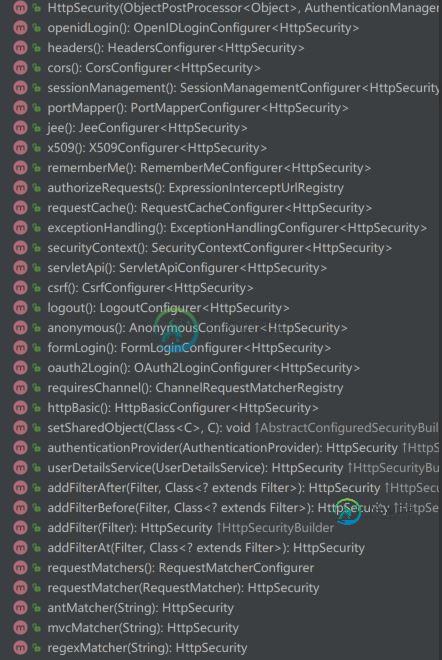Spring Boot2.0使用Spring Security的示例代码
一、Spring Secutity简介
Spring 是一个非常流行和成功的 Java 应用开发框架。Spring Security 基于 Spring 框架,提供了一套 Web 应用安全性的完整解决方案。一般来说,Web 应用的安全性包括用户认证(Authentication)和用户授权(Authorization)两个部分。用户认证指的是验证某个用户是否为系统中的合法主体,也就是说用户能否访问该系统。用户认证一般要求用户提供用户名和密码。系统通过校验用户名和密码来完成认证过程。用户授权指的是验证某个用户是否有权限执行某个操作。在一个系统中,不同用户所具有的权限是不同的。比如对一个文件来说,有的用户只能进行读取,而有的用户可以进行修改。一般来说,系统会为不同的用户分配不同的角色,而每个角色则对应一系列的权限。
对于上面提到的两种应用情景,Spring Security 框架都有很好的支持。在用户认证方面,Spring Security 框架支持主流的认证方式,包括 HTTP 基本认证、HTTP 表单验证、HTTP 摘要认证、OpenID 和 LDAP 等。在用户授权方面,Spring Security 提供了基于角色的访问控制和访问控制列表(Access Control List,ACL),可以对应用中的领域对象进行细粒度的控制。
另外Spring Security也集成了OAuth2.0,接下来我们就介绍下这两种使用的,当然Spring Security还集成CAS等等,如果你要了解更多请查看 官方文档 ,我们下面的都是使用Spring Boot2.0做的demo,2.0以后已经集成了Spring Security5.0以上的版本;
二、Basic认证
这个也是我们经常使用的基于表单的认证,输入一个账号和密码点击登录这种,就是Basic认证,我们接下主要会讲一下使用以及5.0以后做了那些升级;
1.使用以及常用的一些参数的介绍
第一步使用Maven引入Spring Security jia包,这里我们使用Thymeleaf作为前端模板页面,这里也有一个地方可以探讨一波,为什么Spring MVC可以自由切换模板,这个地方我们找个机会一起探讨,这里先做下简单的介绍;
<dependencies> <dependency> <groupId>org.springframework.boot</groupId> <artifactId>spring-boot-starter</artifactId> </dependency> <dependency> <groupId>org.springframework.boot</groupId> <artifactId>spring-boot-starter-security</artifactId> </dependency> <!-- 前端模板 thymeleaf 依赖 --> <dependency> <groupId>org.springframework.boot</groupId> <artifactId>spring-boot-starter-thymeleaf</artifactId> </dependency> <!--安全认证框架--> <dependency> <groupId>org.springframework.boot</groupId> <artifactId>spring-boot-starter-web</artifactId> </dependency> <dependency> <groupId>org.springframework.boot</groupId> <artifactId>spring-boot-starter-test</artifactId> <scope>test</scope> </dependency> <dependency> <groupId>org.springframework.boot</groupId> <artifactId>spring-boot-starter-thymeleaf</artifactId> </dependency> <dependency> <groupId>org.springframework.boot</groupId> <artifactId>spring-boot-starter-security</artifactId> </dependency> </dependencies>
第二步引入Java配置配置方案
这里我们先使用@Configuration和@EnableWebSecurity对Java类进行配置,接下来我们就是继承WebSecurityConfigurerAdapter,对里面的方法重写就可以了,分别是对AuthenticationManagerBuilder,WebSecurity,HttpSecurity方法,我们主要介绍AuthenticationManagerBuilder和HttpSecurity,通过对这两种方法重写最终实现我们自定义认证;
先来介绍一下HttpSecurity常用参数,如下图用法基本脱离不了下面这些方法,可以基于认证的方式有formLogin、openidLogin、oauth2Login,还可以做一些记住账号操作rememberMe,还可以进行session配置管理,还支持登出loginout等等,使用起来还是蛮简单的,大家可以参照一下这篇文章,还是蛮详细的;

接下来我们再看下AuthenticationManagerBuilder,我们重写这个方法,可以基于内存用户认证、数据库认证、LDAP认证、还可以自定义用户服务、还可以自己定义认证。这里我们使用自定义认证的做demo,另外这个大家还可能有一个困惑的点,configGlobal和configure的差别在哪里,这里大家可以 参考下这篇文章 ,Spring Security从3.2版本以后就默认开启了CRSF防护,这里是通过Token方式去检测的,在登陆的时候Thymeleaf模板会生成_csrf的标签来防止CRSF,对CSRF不懂的大家可以看下这篇文章 ,这个里面介绍一些防护CSRF的手段,大家可以思考下,我的demo只是一个简单的架子,为了是给大家介绍一些知识,可扩展大家根据这些介绍的知识可以随心所欲的扩展自己想要的,不要拘泥于一种方法;
最后我还要介绍一下加密的方式,Spring Security 4的时候我们常用的加密方式是MD5加盐的方式,5.0以后版本就找不到Md5PasswordEncoder,说明这个方法还是不够安全,还是可以通过暴力破解可以搞定,可能我不行但是拦不住一些高手,大家可以看下官方支持的以及弃用一些方法:

使用我就不介绍了,有兴趣可以自己探索一波,还可以参考一下 文章一 、文章二 ,下面我粘贴我的代码,讲到的这些可以扩展的地方大家我在代码中会标识清楚,喜欢动手可以尝试一下,我的重点是OAuth2验证;
/**
*自定义认证
* Created by wangt on 2018/7/29.
*/
@Configuration
@EnableWebSecurity
@EnableGlobalMethodSecurity
public class WebSecurityConfig extends WebSecurityConfigurerAdapter {
/**
* http资源认证
* @param http
* @throws Exception
*/
@Override
protected void configure(HttpSecurity http) throws Exception {
http.authorizeRequests()
.antMatchers("/","/home").permitAll()
.anyRequest().authenticated()
.and()
.formLogin()
.loginPage("/login")
.permitAll()
.and()
.logout()
.permitAll();
}
/**
* 自定义认证策略
*/
@Autowired
public void configGlobal(AuthenticationManagerBuilder auth) throws Exception {
auth.authenticationProvider(authProvider()).eraseCredentials(true);
}
@Bean
public AuthProvider authProvider(){
return new AuthProvider();
}
}
/**
* 自定义认证
* Created by wangt on 2018/8/18.
*/
public class AuthProvider implements AuthenticationProvider {
private final BCryptPasswordEncoder bCryptPasswordEncoder=new BCryptPasswordEncoder();
@Override
public Authentication authenticate(Authentication authentication) throws AuthenticationException {
String userName = authentication.getName();
String inputPassword = (String) authentication.getCredentials();
//如果你要使用thymeleaf认证方言可以扩展一下User
//GrantedAuthority这个是使用方言的属性,有兴趣了解下
//其实也就是通过这个使用if去判断
User user =new User();
user.setName("admin");
user.setPassword("admin");
if (user == null) {
throw new AuthenticationCredentialsNotFoundException("authError");
}
//这一块可以自定义一些加密方式
//自己动手实现一下
if (true) {
//这块有好几个构造
//如果使用方言你可以使用3个参数的构造函数
return new UsernamePasswordAuthenticationToken(user, null);
}
throw new BadCredentialsException("authError");
}
@Override
public boolean supports(Class<?> aClass) {
return true;
}
}
/**
* Created by wangt on 2018/8/18.
*/
@Configuration
public class WebMvcConfig implements WebMvcConfigurer {
//如果使用thymeleaf方言在这块扩展
@Override
public void addViewControllers(ViewControllerRegistry registry) {
registry.addViewController("/index").setViewName("index");
registry.addViewController("/").setViewName("index");
registry.addViewController("/hello").setViewName("hello");
registry.addViewController("/login").setViewName("login");
}
}
<!DOCTYPE html>
<html lang="en">
<head>
<meta charset="UTF-8">
<title>Title</title>
</head>
<body>
<!--主页面 index-->
您好!欢迎光临!
<a href="/login">登录</a>
<a href="/hello">限制访问的页面</a>
</body>
</html>
<!DOCTYPE html>
<html lang="en">
<head>
<meta charset="UTF-8">
<title>Title</title>
</head>
<body>
<!--hello页面-->
hello
</body>
</html>
<!DOCTYPE html>
<html xmlns:th="http://www.thymeleaf.org">
<head>
<meta charset="UTF-8">
<title>Title</title>
</head>
<body>
<!--登录页面-->
<form th:action="@{/login}" method="post">
<div><label> User Name : <input type="text" name="username"/> </label></div>
<div><label> Password: <input type="password" name="password"/> </label></div>
<div><input type="submit" value="登录"/></div>
</form>
</body>
</html>
/**
* 登录控制器
* Created by wangt on 2018/8/18.
*/
@Controller
public class LoginController {
@GetMapping("/login")
public String login(){
return "/login";
}
}
/**
* 主页
* Created by wangt on 2018/7/28.
*/
@Controller
public class HomeController {
@GetMapping("/")
public String index(){
return "index";
}
}
/**
* hello页
* Created by wangt on 2018/8/19.
*/
@Controller
public class HelloController {
@GetMapping("/hello")
public String index(){
return "hello";
}
}
以上就是本文的全部内容,希望对大家的学习有所帮助,也希望大家多多支持小牛知识库。
-
本文向大家介绍springboot2.0整合dubbo的示例代码,包括了springboot2.0整合dubbo的示例代码的使用技巧和注意事项,需要的朋友参考一下 写在前面: 使用springboot作为web框架,方便开发许多,做分布式开发,dubbo又不可少,那么怎么整合在一起呢, 跟我学一遍,至少会用 注意,springboot2.0和springboot1.x与dubbo整合不一样, 1.
-
本文向大家介绍springboot2.0集成rabbitmq的示例代码,包括了springboot2.0集成rabbitmq的示例代码的使用技巧和注意事项,需要的朋友参考一下 安装rabbitmq 简介: rabbitmq即一个消息队列,主要用来实现应用程序的异步和解耦,消息缓冲,消息分发的作用. 由于rabbitmq依赖于erlang语言,所以先安装erlang: 添加erlang soluti
-
本例子以https://github.com/weiboad/kafka-php作为客户端。使用composer安装时请先看EasySwoole文档中自动加载的章节, 为EasySwoole引入composer。 如何在EasySwoole中添加自定义阻塞进程 EasySwoole支持在beforeWorker事件中添加自定义进程参与swoole底层的事件循环,具体实例代码为: $serv
-
本文向大家介绍springData使用QueryDsl的示例代码,包括了springData使用QueryDsl的示例代码的使用技巧和注意事项,需要的朋友参考一下 经过多年,spring data jpa越来越完善,在版本迭代的过程中,会不断增加功能,今天看新的reference发现有Querydsl.然后搜索到上面的参考资料2 无论是JpaSpecificationExecutor,还是Quer
-
本文向大家介绍SpringBoot使用Jsp的示例代码,包括了SpringBoot使用Jsp的示例代码的使用技巧和注意事项,需要的朋友参考一下 本文是简单总结一下SpringBoot使用Jsp的Demo。 前言 在早期做项目的时候,JSP是我们经常使用的java服务器页面,其实就是一个简化servlet的设计,在本文开始之前,回顾一下jsp的几大对象,如图。 而在现在SpringBoot框架流行的
-
本文向大家介绍使用Dropzone.js上传的示例代码,包括了使用Dropzone.js上传的示例代码的使用技巧和注意事项,需要的朋友参考一下 本文介绍了使用Dropzone.js上传的示例代码,分享给大家,具体如下: 说明:后台用的python的flask框架,后台对你理解这篇文章没什么影响,你可以使用php form作为上传区 引入Dropzone.js和dropzone.css然后使用表单f

